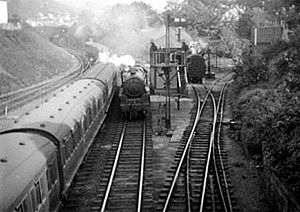Ayrshire Coast Line facts for kids
Quick facts for kids Ayrshire Coast Line |
|
|---|---|

Class 380 train at Troon
|
|
| Overview | |
| Status | Operational |
| Owner | Network Rail |
| Locale | Scotland |
| Stations | 26 |
| Service | |
| Type | Heavy rail |
| System | National Rail |
| Operator(s) | ScotRail |
| Rolling stock | Class 380 and Class 156 |
| Technical | |
| Number of tracks | Double and single line |
| Track gauge | 4 ft 8 1⁄2 in (1,435 mm) |
| Electrification | 25 kV 50 Hz AC |
The Ayrshire Coast Line is a train route in Scotland. It is part of the bigger Strathclyde train network. This line has 26 stations. It connects the Ayrshire coast to Glasgow. There are three main branches. These go to Largs, Ardrossan Harbour and Ayr. All trains on these branches arrive at the high level of Glasgow Central station. The train company ScotRail operates all the trains on this line.
Contents
History of the Ayrshire Coast Line
The Ayrshire Coast Line is made up of several older railway lines. These used to be separate. Some of these old lines include the Glasgow and Paisley Joint Railway. Others were the Glasgow, Paisley, Kilmarnock and Ayr Railway and the Ardrossan Railway. The line also includes the Largs Branch extension.
Electrifying the Line
In September 1986, the train line to Ayr was electrified. This means it was set up to use electricity for the trains. New electric trains, called Class 318s, started running. This was done by British Rail. They called the line the AyrLine in their adverts.
Along with the new trains, many stations were updated. Major work was done on the tracks. Many bridges were also rebuilt. At the same time, old-fashioned semaphore signals were replaced. New, modern signals were put in place. The full electric train service began on January 19, 1987. This included trains to Largs and Ardrossan Harbour. Sometimes, other electric trains, like Class 303s and Class 311s, were also used.
These new electric trains replaced older diesel trains. These included the Class 101 and Class 107 models. They had been used on the line for over 30 years. Older Class 126 diesel trains were also used. But they were taken out of service in the early 1980s.
Train Services in 2023
As of December 2023, there are four trains every hour. They run every 15 minutes between Glasgow Central and Kilwinning. Two of these trains continue on to Ayr. One train an hour goes to Ardrossan Harbour. Another train an hour goes to Largs.
Extra trains run during busy times, called peak hours. All trains stop at Paisley Gilmour Street, Johnstone, and Kilwinning. Sometimes, extra trains run to Ardrossan Harbour. These connect with CalMac ferries going to and from Brodick on the Isle of Arran.
There is also a train service every two hours. This runs between Kilmarnock and Ayr. It stops at Troon and Prestwick on Sundays. On Sundays, there are three trains an hour. Two go to Ayr and one goes to Largs. Four trains per day go to Ardrossan Harbour. These connect with the ferries. There are no Sunday services between Kilmarnock and Ayr.
- Note: Not all Kilmarnock trains stop at Prestwick Town. They also do not stop at Prestwick Airport.
The Train Route

The Ayrshire Coast Line follows the same path as the Inverclyde Line. This is from Glasgow as far as Paisley Gilmour Street. At Paisley Gilmour Street, the trains use different platforms. The line then turns south-west towards Kilwinning. This part follows the route of the old Glasgow, Paisley, Kilmarnock and Ayr Railway.
At Kilwinning, the line splits into two branches. One branch goes south along the coast to Troon and Ayr. This branch also serves Prestwick Airport station. This station opened in 1994. The other branch goes north along the coast. It goes to Ardrossan or Largs. This part of the line becomes a single track for passenger trains after Saltcoats. Beyond Ayr, 'Sprinter' diesel trains continue south. They go towards Girvan and Stranraer.
The line connects with ferries at Ardrossan. These ferries go to Brodick on the Isle of Arran. At Largs, you can connect with ferries to Great Cumbrae.



